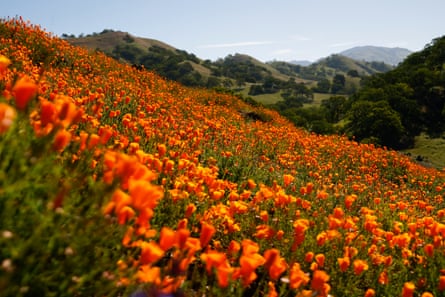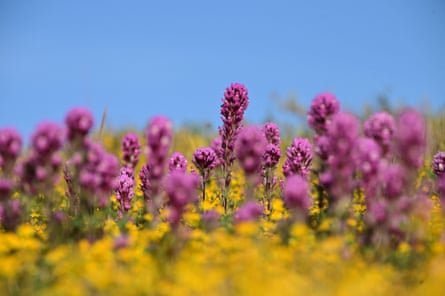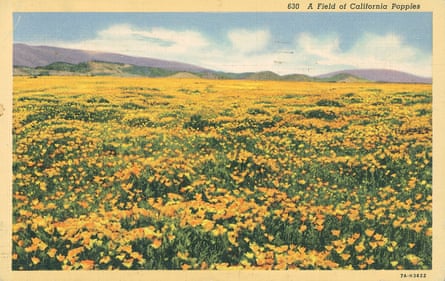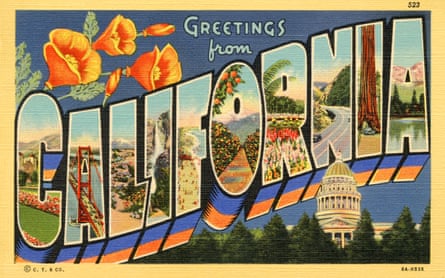This year’s California wildflower superbloom is a historic phenomenon, brought on by an unprecedented wet winter. Miles of golden-orange poppies, purple desert sand-verbena and pink filaree are visible from space. This time of year it seems that everywhere from remote corners of the desert to drab highway medians are bursting with color.
The spectacle draws thousands of visitors every spring, who flock to enjoy the view and take photos of the unique natural spectacle – as people have done for generations.
“People have always been attracted to these incredible natural events,” said Evan Meyer, who directs the Theodore Payne Foundation for Wild Flowers and Native Plants. “These blooms are so much bigger than us, and it shows what a powerful force our biology is: you can’t look at them and not feel inspired.”

But the crowds also can make their own paths through sensitive areas, causing damage and threatening the future of the phenomenon. While debate over how to balance appreciating the superbloom without overwhelming it has intensified in recent years, it reflects concerns about society’s creep into wild places that date back more than a century, particularly during periods of intense growth in the Los Angeles area.
‘Destroying the very thing we cherished’
There is evidence that Indigenous tribes such as the Cahuilla and Serrano have celebrated springtime blooms of chia, alongside other colorful plants, which they also used fire to cultivate. Indigenous groups also ate the poppy as food – boiling or steaming the whole plant. The Spanish colonist Juan Bautista de Anza wrote in 1774 that “fields as verdant as they are flower-covered touch the very waters of the sea”.
Superblooms probably happened about once a decade during the last few hundred years, according to reports compiled by early colonizers, botanists and newspapers. They often come after a drought during a year of El Niño, which typically drops strong winter rains on the region.

The story of wildflowers is complex – in precolonial times, the state’s landscapes were dominated by mass wildflower habitats instead of grasslands, but invasive plants from Europe such as bromegrass – along with grazing animals – triggered a widescale collapse of wildflower habitat.
Newcomers arriving to southern California often turned away from native species and cultivated plants from other parts of the world, said Naomi Fraga, director of conservation at the California Botanic Garden – palm trees from Mexico and succulents from Africa, without fully understanding or appreciating native species that were already here.
The California poppy was selected as the state flower in 1903, signaling the flower’s ascendancy as a symbol of nature in the region. Tourism began to blossom in the 1900s, the region was also growing, shifting from a rural community to one of the biggest metropolises in the nation.

People were flocking to the region to see the flowers before the idea of public lands protected from development was fully formed – the National Park Service wasn’t founded until 1916 – and didn’t think about conservation in the modern sense, said Meyer. Society was much more focused on developing the Central Valley and Los Angeles basin than considering the impact of tourism and development on the environment.
It was ironic, he notes, that the state cherished the very things that it was destroying: “[California] was creating postcards of the poppy fields of Altadena before they were all paved over and turned in to housing.”
The paving of California’s wild spaces also took away ecosystems that sequester carbon and made it easier for vehicles that spew carbon, contributing to the climate crisis, said Fraga. There was an interesting connection between wildflowers and transportation – poppies were often depicted on posters or advertisements that also had trains, and later automobiles. Ridgefield gas stations used to pass out botanically-accurate wildflower brochures, encouraging people to drive around to see the flowers (and, of course, they’d sell more gas along the way).

The rhetoric of the early 20th century focused on conquering the landscape and demonstrating how man can take over nature, said Stacey Camp, an anthropologist at Michigan State University who wrote her doctoral thesis on California nature tourism. “So when they get out there, tourism is really based around making white folks feel safe out in nature.” She notes that a switch occurred after the western US mushroomed into populated cities: a creeping nostalgia for nature emerged, and the environment was reframed as something to preserve and cherish.
When Fraga looks at photographs of people in fields in Pasadena with handfuls of poppies at the turn of the 20th century, she surmises they had a feeling of abundance: at the time, even in the middle of LA county, there were expansive fields of flowers – probably millions of acres. “I don’t think those tourists could have known what was to come and how those fields could be diminished by rapid development,” she said. “So while their picking flowers was not necessarily beneficial for those wildflower fields back then (same as it is now), the scale of it was not as significant because there were less tourists and many more poppy fields then what is currently left.”
“There wasn’t an understanding of how quickly these could be lost,” she said. “It links to the same issues we see today – a disconnect with the natural landscape of southern California.”

Seeds of the future
Today, people are still wrestling with questions of how to appreciate this phenomenal superbloom while making sure it lasts. This year’s bloom lays the groundwork, quite literally, for the next one: as annual plants, the seeds dispersed as the flowers bloom can lie in wait, biding their time for the precise conditions when they open up to the world. Some experiments have shown seeds can still germinate for more than 70 years after they have popped out of flowers.
Trampling the fields or harming the flowers not only hurts this year’s bloom, but also can damage the seeds for the next one, preventing the flowers from reappearing. Habitat fragmentation plays a role, too – many areas of flower fields are being developed for housing, solar installations or mining, Meyer said.
“The problem is that we live in a culture that’s kind of disconnected from nature.”

“We are now more extractive and domineering in the habitat,” he said, adding that even people visiting the fields for social media posts are in some way extracting value from them without returning anything. “There are people trying to confront that and be more reciprocal with these lands, but there is a lot of work to be done.”
An artist named Fritz Haeg has started to push back against the loss of wildflowers, encouraging people to plant native wildflowers in their yard to create urban superblooms in a project called Wildflowering LA which started in 2013. The project took a typical drab urban landscape and transformed them into bursts of color – in addition to helping pollinators and other local fauna.
Still, when Meyer sees the flowers, it gives him a sense of awe at the enormousness of it, and hope for the future. “One of the really hopeful things about this whole phenomenon is how exuberant nature is, and how resilient it is,” he said. “With the right planning and foresight there’s no reason we can’t live with thousands of flowers around us all the time.”

 1 year ago
82
1 year ago
82










 English (US)
English (US)